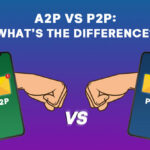
Email marketing comes with its own set of vocabulary that businesses need to familiarise themselves with. When you’re just getting started with email marketing, you’ll quickly notice that there’s some new terminology to learn. A common term that you’ll hear quite often is “bounced email.” What does this phrase mean?
This article is intended for business owners who want to improve their email marketing strategy’s effectiveness. Let’s take a look at what a bounced email is, how to differentiate between hard and soft bounces, and why keeping your email bounce rate low is important for your sender reputation.
What Does Bounced Email Mean?

If any of your emails doesn’t reach its intended recipient, it ‘bounces’. This means that the email was rejected by the recipient email server, either temporarily or permanently. Usually, you’ll receive an auto-response when such delivery failures happen, informing you that your email bounced.
Soft Bounce vs Hard Bounce Email
An email can bounce for different reasons and these differences are usually defined as either a soft or a hard bounce. Understanding the differences between soft bounce vs. hard bounce emails can help you identify what to improve upon for your email marketing efforts.
Hard Bounce
A hard bounce is an email that cannot be delivered due to permanent reasons that cannot be fixed. A hard bounce typically occurs when the recipient’s email address is invalid or no longer in use.
In some cases, the person could have accidentally mistyped their email address when filling up the subscription form for your business newsletter.
Common reasons for a hard bounce to happen:
- Fake or non-existent recipient email address.
- Fake or non-existent email domains.
- Outdated email list.
- Rented or paid-for email list.
You want to avoid getting hard bounces as much as possible because they can hurt your email deliverability rate and sender reputation. We’ll get to that later in this article.
Related topic: How to Easily Collect Email Addresses for Free
Soft Bounce
A soft bounce is an email that was not delivered due to a temporary problem. Unlike a hard bounce, a soft bounce is an email delivery issue that can be fixed.
Common reasons for a soft bounce to happen:
- Full mailbox (over quota).
- Inactive mailbox.
- The recipient email server is down or offline.
- Content in your email message is blocked or too large.
- Your email message does not meet the recipient server’s policies.
- Your email message does not meet the recipient server’s DMARC requirements for authentication.
- Your email message does not meet the recipient server’s anti-spam requirements.
- Your email message does not meet the recipient server’s anti-virus requirements.
If it is any of the above reasons, most email providers will try and resend the email a few more times. However, if the email continues to see delivery failure, consider that recipient address a bad one and remove it from your list.
On the elfoMAP platform, you can easily check your email lists for common issues as they are imported. Here, you can find out when an email address is no longer active, is misspelled, or when the recipient wants to unsubscribe. elfoMAP can be set to automatically remove these from your list so that your email deliverability rate isn’t affected.
Related topic: How to Ensure Your Emails Avoid Spam Filters
How to Calculate Email Bounce Rate

As your business continues to grow its mailing lists while carrying out bigger email marketing campaigns, it is inevitable to see a number of bounced emails. However, a high bounce rate is a real problem.
On average, your bounce rate should be no more than 2%. If you can get it to a lower percentage, the better your sender reputation will be.
Here is the formula used by marketers to track email bounce rate:
(Bounced emails ÷ Total emails sent) x 100 = Email bounce rate
What Is Sender Reputation And Why It Matters for Your Business
Unique to email marketing, sender reputation is a metric that analyzes the quality of your mailing list based on what email practices your business follows. How often your emails bounce can affect this data.
Internet service providers (ISPs) use this data to assess whether or not recipients should accept emails from certain addresses. If it is determined that the email address your business uses has a poor sender reputation, your emails will frequently bounce back or automatically filter to the spam folder.
Thus, the best way to reduce the number of bounces is by following key email deliverability best practices. This article provides a comprehensive list.
Soft Bounce vs Hard Bounce Email: Key Takeaway

Email marketing offers small businesses a great opportunity to build relationships with their target audience and achieve high ROI. Growing a healthy email list is an essential part of building your business, but it comes with its own challenges to be mindful of.
The credibility of your sender reputation can quickly deteriorate if you get too many bounced emails. You don’t want to do the hard work of building an email list only to end up with a high bounce rate.
It isn’t possible to prevent bounced emails entirely, but you can limit the number of hard bounces you experience. Reduce your email bounce rate by entrusting all your email marketing campaigns to a platform like elfoMAP to improve customer engagement and get successful outcomes.
Pick up a free trial of elfoMAP today to help your brand reach its full potential!




